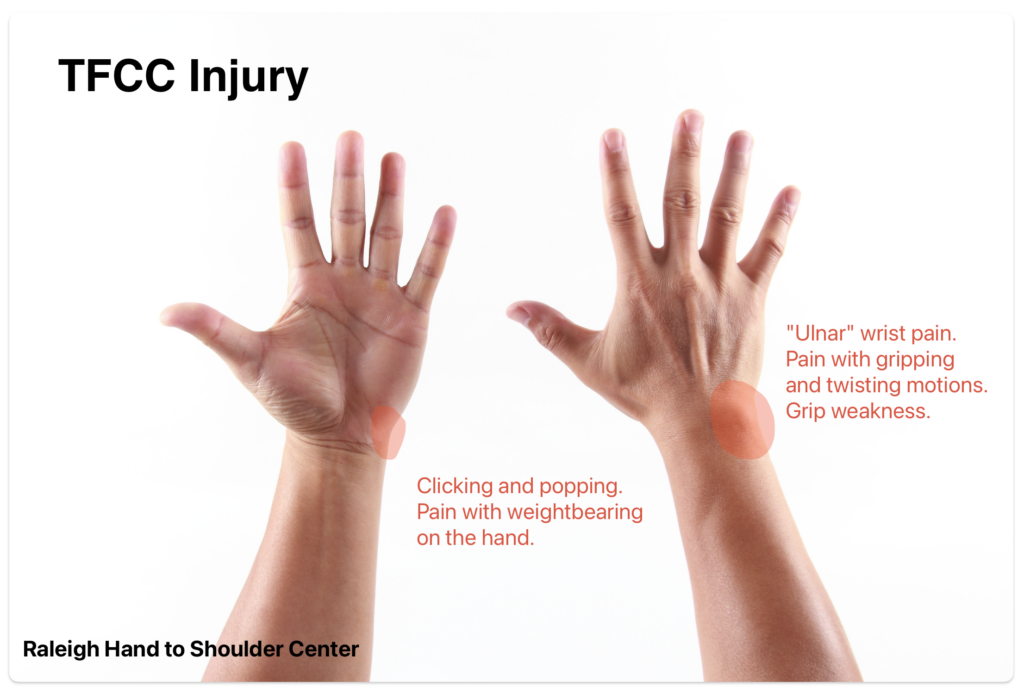
TFCC Tear in Wrist
What is a TFCC Tear in the Wrist?
The wrist is a versatile joint that allows us to position the hand in space to perform the most complex of functions. This requires the wrist joint to be flexible and strong. The radius and ulna bones, along with eight small carpal bones comprise the wrist. Ligaments connect these bones and a few of these ligaments are prone to injury.
The triangular fibrocartilage complex (TFCC) is a group of cartilage and ligaments located on the side of the wrist below the small finger. This area is called the ulnar side of the wrist. When this area is injured, it can cause chronic wrist pain. Many patients diagnosed with a “wrist sprain” have injury to this area. TFCC injuries are a common cause for ulnar sided wrist pain.

What is the Function of the Triangular Fibrocartilage Complex (TFCC)?
This ligament stabilizes the ends of the two forearm bones (radius and ulna) during grip activities and forearm rotation. It also helps cushion and suspend the carpal bones of the wrist.
How is the TFCC Ligament Injured?
There are two types of TFCC injuries: acute and chronic. A fall on an outstretched hand or excessive rotation of the forearm are frequent causes of acute TFCC tears. These injuries often occur in conjunction with a distal radius fracture. Chronic tears are caused by a degenerative process that wears the ligament down over time. In some patients, the ulna bone can pinch the TFCC ligament between the carpal bones due to excessive length, subsequently wearing a hole in the ligament. Inflammatory disorders such as gout and rheumatoid arthritis can also lead to a chronic, degenerative tear.
What are the Symptoms of a Triangular Fibrocartilage Complex Tear?
Pain is the most common symptom of both acute and chronic tears. Pain typically increases at the wrist on the side of the small finger during grip activities and forearm rotation. Gripping with the hand and twisting the wrist, such as turning a doorknob or swinging a tennis racket, can reproduce the pain from a TFCC injury. Many patients complain of a popping or clicking sensation in the wrist with use. Acute injury findings can range from mild wrist swelling and bruising to joint instability or dislocation of the distal radioulnar joint (DRUJ).
What Treatment Options Are Available for TFCC Tears?
Most TFCC tears resolve with activity modification, splinting, hand therapy, and non-steroidal anti-inflammatory (NSAIDs) medications. If symptoms persist, a corticosteroid injection in the area of the ligament can be helpful to reduce pain. Ulnar sided wrist soreness can last for several months following this injury. Operative treatment may be required for persistent symptoms despite appropriate splinting and injection. TFCC tears resulting in instability of the wrist or in association with wrist fractures may require repair.
What is TFCC Tear Surgery?
The type of surgery varies depending on the location of the tear in the ligament and the chronicity of the injury. The small ligament can be divided into three distinct zones: radial, central, and ulnar (or peripheral). Tears located on the radial and central portion of ligament are typically treated by debriding or cleaning-up the torn edges of the ligament. Fortunately, this can be done arthroscopically with a “wrist scope” through small incisions. Ulnar (peripheral) TFCC tears do have adequate blood flow to allow healing after repair of the ligament. The repair can be accomplished either arthroscopically or using an open technique depending on physician preference and specific characteristics of the injury.
Chronic tears many times are related to excess length of the ulnar bone pinching the TFCC. This disorder is called Ulnar Impaction Syndrome. If the ulnar bone is too long, it typically causes a central tear of the ligament. Along with arthroscopic debridement of the tear, it can help to shorten the ulna bone to prevent re-injury. This can be accomplished by an ulnar shortening osteotomy surgery.
What Kinds of Complications Can Occur with TFCC Tear Surgery?
Complications are rare especially with arthroscopic treatment techniques. Stiffness, sensory nerve injury, persistent wrist pain, and infection have all been reported in the literature with surgical treatment of TFCC tears. If an ulnar shortening osteotomy is required, non-union of the bone and pain in the location of the plate can occur infrequently.
How Much Rehabilitation is Required After the Surgery for a TFCC Tear?
If the ligament is debrided or cleaned-up, the patient's grip strength and motion typically improve within a few weeks. The wrist is often placed in a splint for two to six weeks after surgery and then the patient is allowed to start strengthening and stretching the wrist, guided by hand therapy. If a ligament repair is performed, the ligament needs to be protected and the wrist immobilized for approximately six weeks to allow for healing. Incremental stretching and strengthening is then performed for the next few weeks. Soreness in the ulnar side of the wrist is common for several months following surgery.
Let Us Treat Your TFCC Tear
A TFCC (Triangular Fibrocartilage Complex) tear in the wrist can be a frustrating issue, affecting your daily life, but there's hope for pain relief and improved function. Our team of experts in TFCC wrist tears is here to provide you with the latest treatments and solutions to address your pain and discomfort. Call our office to schedule an appointment with one of our doctors.

Updated 6/21/2025

